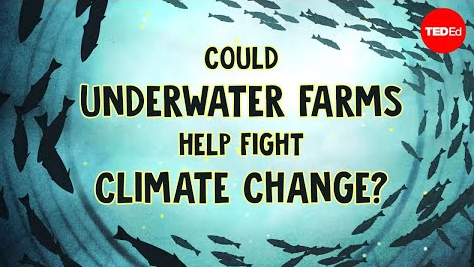For 3 billion people around the world, seafood provides a significant source of protein and nutrition.
世界上有三十亿人以海产品为重要的蛋白质和营养来源。
But recent studies show that 33% of wild fisheries are overfished, while another 60% are fished at their maximum capacity.
而近期研究显示,有33%的野生渔场遭到过度捕捞,还有60%已经达到了极限。
In fact, over half the seafood we eat -- from finfish and shellfish to seaweed and algae -- isn't caught in the wild.
事实上,我们食用的海产品--鱼类、贝类、海草、水藻--一半以上不是野生的。
It's grown through aquaculture, or aquatic farming.
而是水产养殖的产物。
Farmed seafood is one of the fastest-growing food industries, expanding in volume by 5.8% each year.
水产养殖是食品工业界发展最快的分支之一,每年产量增加5.8%。
But different methods of aquaculture come with different advantages and issues
但是不同类型的水产养殖各有优点和问题,
some of which echo the serious problems we've seen in industrial agriculture.
其带来的问题与工业化农业不无相似之处。
So how can we avoid repeating the mistakes we've made on land, at sea?
我们应该如何避免陆上问题在海域重演?
What aquaculture approaches are we currently using, and what does a sustainable way to farm the ocean really look like?
现今水产养殖是如何进行的,可持续的养殖方式又应该是什么样的?
One of the most common aquaculture methods involves large pens made of nets,
一种最常见的养殖方式是网圈养殖,
where fish are farmed offshore in floating cages roughly 1000 square meters in size.
在海里大约1000平方米的漂浮笼子里养殖鱼。
Commonly employed off the coast of Chile and in the fjords of Norway,
这种养殖方式常见于智利海域和挪威峡湾,
these fish, like many industrially farmed animals, occupy stressful, overcrowded pens.
这些鱼就像工业化农业养殖的牲畜,生活环境狭小、拥挤。
They produce massive amounts of waste, polluting the surrounding areas and potentially spreading diseases to wild species.
他们产生的大量排泄物污染着附近的海域,还可能把疾病传播给野生生物。
Worse still, since the antibiotics employed to fight disease aren't fully absorbed by the fish, they get excreted back into the environment.
更糟糕的是,养殖鱼不能完全吸收人们控制疫情所用的抗生素,抗生素会被排放到周边环境中。
Net pens are also susceptible to escapes,
同时,鱼很容易从这种网笼中逃出,
unleashing huge numbers of fish which compete for resources and weaken the local gene pool with genes adapted for captivity.
大量逃出的鱼会与野生鱼争夺资源、其适合圈养的基因也会削弱当地鱼类基因库。
Escaped fish can even disrupt local ecosystems as invasive species.
出逃的鱼作为外来物种就此扰乱了生态系统。
Other techniques, such as man-made coastal ponds commonly used for shrimp farming in Southeast Asia, create additional environmental problems.
其他的养殖方法,例如东南亚养虾业常用的人造近海水塘,也会带来环境问题。

Just like net pens, these ponds are prone to spreading pollution and disease.
和网制鱼笼一样,这些水塘很容易造成污染、传播疾病。
Their construction also frequently destroys important ecosystems like mangroves and marshes,
建造水塘也经常会破坏重要的生态系统,比如红树林和沼泽地,
which protect coastal areas from storms, provide habitats, and absorb tons of greenhouse gases.
它们可保护近海免受风暴袭击、为生物提供栖息地、以及吸收大量温室气体。
One way to solve these problems is to farm fish on land in completely contained systems.
解决问题的方法之一,就是在陆地上、全封闭环境中养殖水产。
Tanks and raceways can recirculate and filter water to prevent pollution.
人工蓄水池和水道可以循环过滤,以防污染。
But even fully contained facilities still contend with another major hurdle: fishmeal.
但即使是全封闭的系统也面临另一个主要困难:鱼粉(一种饲料)供给。
About 10% of the seafood caught globally is used to feed animals, including carnivorous farmed fish.
世界上水产捕捞的10%是用来饲养动物的,包括养殖的肉食鱼。
Researchers are working on fish feed made of insects and plant-based proteins,
研究人员正在尝试用昆虫和植物蛋白质制造鱼食,
but for now many inland fish farms are connected to overfishing.
但是,目前很多内陆渔场都与过度捕捞有关。
All these obstacles can make sustainable aquaculture feel a long way off,
所有这些困难让可持续的水产养殖看起来遥不可及,
but innovative farmers are finding new ways to responsibly farm the seas.
但是富有创意的渔农们正在寻求改进海洋养殖的方法。
The most promising solution of all may be to look lower on the food chain.
最有希望的一种方法是到食物链底端去找答案。
Instead of cramming large, carnivorous fish into pens,
无需再把体型大的食肉鱼类养在笼子里,
we can work with natural ocean systems to produce huge amounts of shellfish and seaweeds.
我们可以在自然海域中养殖大量贝类和藻类。
These low-maintenance flora and fauna don't need to be fed at all.
这些低维护的动植物群不需要喂养。
In fact, they naturally improve water quality, filtering it as they feed off of sunlight and nutrients in the seawater.
事实上,它们自然地改善了水质,它们从海水中摄取阳光和养分的同时,也过滤了海水。
By absorbing carbon through photosynthesis, these farms help battle climate change,
这些养殖场通过光合作用吸收二氧化碳,帮助对抗气候变化,
and reduce local ocean acidification while creating habitats for other species to thrive.
并减少当地海域水体酸化,同时也为其它生物的繁荣提供了生存空间。
Shifting to restorative ocean farming could provide good jobs for coastal communities,
这种可自我修复的海洋养殖方法,可以为近海地区提供良好就业,
and support healthy plant and shellfish-based diets that have an incredibly low carbon footprint.
并提供以素食和贝类为基础的健康饮食,它们的碳排放量非常低。
In just 5 months, 4,000 square meters of ocean can produce 25 tons of seaweed and 250,000 of shellfish.
仅仅5个月内,四千平方米的海域就可以产出25吨海藻、25万个贝类。
With the right distribution network, a series of small farms, collectively the size of Washington State could feed the planet.
如果合理分配,总面积与华盛顿州相当的一群小渔场就可以满足全球食物供给。
Farms like these are already popping up around the globe, and a new generation of farmers is stepping up to pursue a more sustainable future.
类似渔场已在世界一些地区出现,新一代渔民们正在努力追求一个更加可持续发展的未来。
Done properly, regenerative ocean farming could play a vital role in helping our oceans, our climate, and ourselves.
如若方法得当,再生型海洋养殖可在帮助我们的海洋、气候和我们自己方面发挥至关重要的作用。


